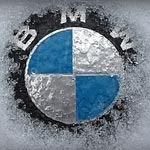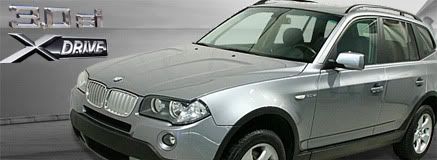Discussions sur tout ce qui touche le domaine de l'automobile. Que ce soit le lancement d'une nouvelle voiture ou d'un concept, les ventes mensuelles des manufacturiers ou autres nouvelles les touchant, c'est ici que ça se discute.
Forum rules
- AVIS IMPORTANT -
Les propos tenus sur le forum de ce site n'engagent que leurs auteurs et ne sont en aucun cas sous la responsabilité de AutoZoneQuébec.com ou d'Essai-Auto.com. Nous nous réservons le droit d'effacer tout message jugé désobligeant ou offensant.
-
Jeece
- Posts:1968
- Joined:Fri Jun 05, 2009 8:48 pm
- Location:Granby
Nouveau moteur Ford SuperDuty Scorpion, V8 6.7 diesel
Post
by Jeece » Wed Sep 02, 2009 12:11 pm
Enfin, dewors le Navistar!

Ford remplace le moteur du SuperDuty par un design maison... En espérant que ces nouvelles idées soient plus que de la théorie...
Article sur Auto-Blog
Beware the Scorpion! 2011 Ford Super Duty gets all-new 6.7-liter diesel V8
The 2011 edition of the Ford Super Duty pickup will get an all-new diesel V8 designed in-house code-named Scorpion. So now, if Ford has any durability issues with its big diesels, it will have no one to blame but itself.
Officially the Scorpion retains the Power Stroke badge, but that and eight cylinders in a V-configuration are all that is carried over. The Scorpion engine picks up a variety of technologies that have been appearing on other recent engines, both gas- and diesel-fueled, as well as adding a few new tricks, particularly the turbocharger. The biggest change for the architecture is the move to an inside-out layout. Since the early days of the V-engine configuration, most examples have had the intake system mounted in the valley between the banks with the exhaust on the outside. Like BMW's new turbocharged gas V8 and GM's current on-the-shelf Duramax 4500, the Scorpion switches this around.
A turbocharger uses the engine's exhaust gases to spin up a turbine that in turn drives a compressor to push more air into the engine, thus making more power. The beauty of the system is that it consumes very little energy under light load conditions and allows smaller engine displacements with equal power to larger ones for improved efficiency most of the time. When extra power is needed, the turbo helps expand the engine's operating range on-demand. Therein lies the rub, the on-demand part.
Turbos of course are not immune to physics and most people have heard of turbo-lag. That's the time delta between when the driver pushes the accelerator and all that "on-demand" power actually becomes available. There are two main causes of lag. One is the time it takes for the exhaust gases to actually get from the cylinder to the turbocharger and apply pressure to the turbine. Over the years, engine designers have attempted to address this by moving the turbo physically closer to the exhaust ports. This is problematic on a V engine with two sets of exhaust ports so the exhaust has to be plumbed around the engine to the turbo. One solution is to mount two turbos, one on each cylinder bank with very short exhaust manifolds. This however, adds cost, weight and complexity.
The alternative is the inside-out layout. By essentially reversing the flow direction through the cylinder heads with the exhaust exiting in the valley, extremely short manifolds can be used to feed a single turbo mounted on top of the engine. In this way the turbo spins up much more quickly, delivering compressed air to the intake runners, which wrap around the ends of the cylinder heads to the outboard-mounted intake ports.
The other source of lag is the turbo itself. Any device that rotates at speeds up to 100,000 rpm will be subject to the limits of inertia. The larger the rotating mass, the more energy it takes to spin it up to speed. The radius of the mass also impacts the inertia. The previously mentioned sequential turbo systems combat this by using a smaller turbo for light load, low speed conditions. As the exhaust flow energy increases it is diverted to a larger turbo with more capacity. Another solution has been to use a variable vane turbo where adjustable venturis in the inlet tract are used to increase the velocity of the exhaust stream. helps to spin up the turbo faster.
The Scorpion features a brand new turbocharger design from Honeywell that we will likely see in many more applications in the coming years. It combines the principle of the sequential turbo approach with the variable vane system. However, instead of two separate turbochargers, two smaller diameter ones are mounted in one housing on a common shaft. The smaller diameter reduces the rotational inertia of the system while still allowing for sufficient flow capacity at higher speeds. It also eliminates the extra plumbing complexity of a dual turbo setup.
Besides performance, the new architecture affords a number of other benefits. The turbo plumbing on the current Navistar supplied PowerStroke engine means that the cab has to be removed from the frame to access the turbocharger. With the turbo now sitting directly on top of the engine, that is no longer an issue and assorted other components are also now more accessible.
Beyond the new turbo technology and layout, most of the rest of the engine is becoming increasingly common place. In order to meet the latest emissions standards, the Scorpion features many of the same technologies found on the latest light duty diesels. The Bosch common rail fuel injection system operates at 30,000 psi and the piezo-electric injectors can provide up to five pulses per power cycle. The multiple fuel pulses spread the power delivery and reduce the combustion temperature. The effect is that the engine runs cleaner, producing less soot and NOx, while using less fuel and producing more power at the same time.
However, the engine still needs extra help down stream. The after-treatment system kicks off with the usual oxidation catalyst that eliminates unburned hydrocarbons and also increases the exhaust temperature. The increased temperature helps improve the efficiency of the selective catalytic reduction (SCR) system. The SCR is the increasingly common urea injection. A solution of 2/3 water and 1/3 urea is injected into the exhaust stream where the urea decomposes into ammonia that reacts in a second catalyst to turn NOx into nitrogen and water. Lastly the exhaust passes through a particulate filter to trap most of the remaining soot.
Finally Ford has sought to reduce the mass and improve the durability of the new diesel. Ford and Peugeot were the first automakers to use compacted graphite iron for diesel engine blocks for their jointly designed 2.7-liter V6 that debuted back in 2003. Since then Audi has also used the material for some of its diesels including the V12 used in the R10 TDI race car. The CGI block has double the strength of typical gray iron and better fatigue resistance. This allows Ford to make the block lighter with thinner walls without sacrificing durability. Ford claims the engines have been run continuously on the dynamometer for the equivalent of 250,000 miles without problems.
The aluminum cylinder heads have dual water jackets to ensure they stay cool enough to withstand 2,600 psi combustion pressures. Also aiding the weight reduction measures is the use of a push-rod valve-train. In spite of the cam in block layout, the Scorpion still has four valves per cylinder as we saw in a Ford patent filing several months ago.
So far Ford isn't releasing much in the way of specifications for either power or efficiency of the new engine other than to say that it is both more powerful and more efficient than the engine it replaces. It will be debuting on the refreshed 2011 Super Duty pickups that we will learn more about soon.
There is one last little tidbit that fleet users will be happy to learn about. Like the 2010 version of GM's 6.6-liter Duramax, the 6.7-liter Power Stroke will be fully compatible with B20 biodiesel blends, addressing one of the issues some current Power Stroke operators have had. Because the current engine injects some fuel into the exhaust stream for particulate filter regeneration, the use of B20 has caused damage to some engines. This will no longer be true for the new engine.
Rotary engines are the original hybrid. They burn gasoline and oil by design.
Ford Fusion SEL 2010
-
Alain31 - Posts:3016
- Joined:Fri Jun 05, 2009 3:58 pm
Post
by Alain31 » Wed Sep 02, 2009 1:15 pm
Jeece wrote:Enfin, dewors le Navistar!

Ford remplace le moteur du SuperDuty par un design maison... En espérant que ces nouvelles idées soient plus que de la théorie...
Article sur Auto-Blog
Beware the Scorpion! 2011 Ford Super Duty gets all-new 6.7-liter diesel V8
The 2011 edition of the Ford Super Duty pickup will get an all-new diesel V8 designed in-house code-named Scorpion. So now, if Ford has any durability issues with its big diesels, it will have no one to blame but itself.
Officially the Scorpion retains the Power Stroke badge, but that and eight cylinders in a V-configuration are all that is carried over. The Scorpion engine picks up a variety of technologies that have been appearing on other recent engines, both gas- and diesel-fueled, as well as adding a few new tricks, particularly the turbocharger. The biggest change for the architecture is the move to an inside-out layout. Since the early days of the V-engine configuration, most examples have had the intake system mounted in the valley between the banks with the exhaust on the outside. Like BMW's new turbocharged gas V8 and GM's current on-the-shelf Duramax 4500, the Scorpion switches this around.
A turbocharger uses the engine's exhaust gases to spin up a turbine that in turn drives a compressor to push more air into the engine, thus making more power. The beauty of the system is that it consumes very little energy under light load conditions and allows smaller engine displacements with equal power to larger ones for improved efficiency most of the time. When extra power is needed, the turbo helps expand the engine's operating range on-demand. Therein lies the rub, the on-demand part.
Turbos of course are not immune to physics and most people have heard of turbo-lag. That's the time delta between when the driver pushes the accelerator and all that "on-demand" power actually becomes available. There are two main causes of lag. One is the time it takes for the exhaust gases to actually get from the cylinder to the turbocharger and apply pressure to the turbine. Over the years, engine designers have attempted to address this by moving the turbo physically closer to the exhaust ports. This is problematic on a V engine with two sets of exhaust ports so the exhaust has to be plumbed around the engine to the turbo. One solution is to mount two turbos, one on each cylinder bank with very short exhaust manifolds. This however, adds cost, weight and complexity.
The alternative is the inside-out layout. By essentially reversing the flow direction through the cylinder heads with the exhaust exiting in the valley, extremely short manifolds can be used to feed a single turbo mounted on top of the engine. In this way the turbo spins up much more quickly, delivering compressed air to the intake runners, which wrap around the ends of the cylinder heads to the outboard-mounted intake ports.
The other source of lag is the turbo itself. Any device that rotates at speeds up to 100,000 rpm will be subject to the limits of inertia. The larger the rotating mass, the more energy it takes to spin it up to speed. The radius of the mass also impacts the inertia. The previously mentioned sequential turbo systems combat this by using a smaller turbo for light load, low speed conditions. As the exhaust flow energy increases it is diverted to a larger turbo with more capacity. Another solution has been to use a variable vane turbo where adjustable venturis in the inlet tract are used to increase the velocity of the exhaust stream. helps to spin up the turbo faster.
The Scorpion features a brand new turbocharger design from Honeywell that we will likely see in many more applications in the coming years. It combines the principle of the sequential turbo approach with the variable vane system. However, instead of two separate turbochargers, two smaller diameter ones are mounted in one housing on a common shaft. The smaller diameter reduces the rotational inertia of the system while still allowing for sufficient flow capacity at higher speeds. It also eliminates the extra plumbing complexity of a dual turbo setup.
Besides performance, the new architecture affords a number of other benefits. The turbo plumbing on the current Navistar supplied PowerStroke engine means that the cab has to be removed from the frame to access the turbocharger. With the turbo now sitting directly on top of the engine, that is no longer an issue and assorted other components are also now more accessible.
Beyond the new turbo technology and layout, most of the rest of the engine is becoming increasingly common place. In order to meet the latest emissions standards, the Scorpion features many of the same technologies found on the latest light duty diesels. The Bosch common rail fuel injection system operates at 30,000 psi and the piezo-electric injectors can provide up to five pulses per power cycle. The multiple fuel pulses spread the power delivery and reduce the combustion temperature. The effect is that the engine runs cleaner, producing less soot and NOx, while using less fuel and producing more power at the same time.
However, the engine still needs extra help down stream. The after-treatment system kicks off with the usual oxidation catalyst that eliminates unburned hydrocarbons and also increases the exhaust temperature. The increased temperature helps improve the efficiency of the selective catalytic reduction (SCR) system. The SCR is the increasingly common urea injection. A solution of 2/3 water and 1/3 urea is injected into the exhaust stream where the urea decomposes into ammonia that reacts in a second catalyst to turn NOx into nitrogen and water. Lastly the exhaust passes through a particulate filter to trap most of the remaining soot.
Finally Ford has sought to reduce the mass and improve the durability of the new diesel. Ford and Peugeot were the first automakers to use compacted graphite iron for diesel engine blocks for their jointly designed 2.7-liter V6 that debuted back in 2003. Since then Audi has also used the material for some of its diesels including the V12 used in the R10 TDI race car. The CGI block has double the strength of typical gray iron and better fatigue resistance. This allows Ford to make the block lighter with thinner walls without sacrificing durability. Ford claims the engines have been run continuously on the dynamometer for the equivalent of 250,000 miles without problems.
The aluminum cylinder heads have dual water jackets to ensure they stay cool enough to withstand 2,600 psi combustion pressures. Also aiding the weight reduction measures is the use of a push-rod valve-train. In spite of the cam in block layout, the Scorpion still has four valves per cylinder as we saw in a Ford patent filing several months ago.
So far Ford isn't releasing much in the way of specifications for either power or efficiency of the new engine other than to say that it is both more powerful and more efficient than the engine it replaces. It will be debuting on the refreshed 2011 Super Duty pickups that we will learn more about soon.
There is one last little tidbit that fleet users will be happy to learn about. Like the 2010 version of GM's 6.6-liter Duramax, the 6.7-liter Power Stroke will be fully compatible with B20 biodiesel blends, addressing one of the issues some current Power Stroke operators have had. Because the current engine injects some fuel into the exhaust stream for particulate filter regeneration, the use of B20 has caused damage to some engines. This will no longer be true for the new engine.
Le turbo vient d'Honeywell... probablement le même qu'on retrouve dans les Ecoboost.
Kia Forte EX berline 2015 2.0L 6 vit. auto 6.9L/100km (route) 9.1L/100km (urbain)
Nissan Rogue SL 2015 CVT AWD 7.1L/100km (route) 10.1L/100km (urbain)
-
hyksos
- Posts:4165
- Joined:Sat Jun 06, 2009 8:58 pm
Post
by hyksos » Wed Sep 02, 2009 1:43 pm
Alain31 wrote:
Le turbo vient d'Honeywell... probablement le même qu'on retrouve dans les Ecoboost.
J'espère que non.... sinon il va s'essouffler vite en sacramant avec plus du double de la cylindré et les minuscule turbo du Ecoboost... surtout que ce moteur aura un seul turbo, OUTCH!
Pis c'est bien écrit
brand new turbocharger design
C'est un turbo à géométire variable, ce que les turbos du écoboost ne font pas.
-
Jeece
- Posts:1968
- Joined:Fri Jun 05, 2009 8:48 pm
- Location:Granby
Post
by Jeece » Wed Sep 02, 2009 2:06 pm
Ouep, géométrie variable, et 2 sets de turbines sur un seul shaft. Donc un seul casing de turbo, avec 2 entrées/sorties.
Photos:
PhotosRotary engines are the original hybrid. They burn gasoline and oil by design.
Ford Fusion SEL 2010
-
Ziglabeu
- Posts:1132
- Joined:Sat Jun 06, 2009 7:53 am
Post
by Ziglabeu » Wed Sep 02, 2009 3:04 pm
Y'on rien inventé la... mitsubishi et subaru utilise le twin scroll depuis 5-6 ans sur les modèle jap des Evo et STi...



